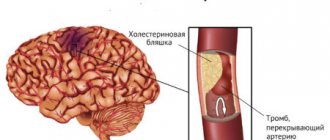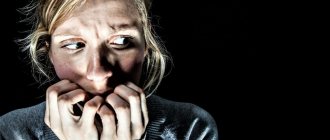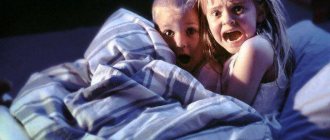It’s easy for everyone to remember what they were afraid of as a child. Some people talk about this with laughter, others are still worried about “scary” images. In psychology, fear is considered a specific psycho-emotional state in front of approaching danger. It is based on the instinct of self-preservation and has a protective function. Therefore, children's fears do not surprise anyone and are a normal reaction, since children who have no life experience are afraid of many things.
Fear is a negative emotional state that all people experience.
The concept of childhood fear, what is it
It has been proven that phobias appear in children from one and a half to 16 years of age. They are based on a feeling of anxiety and concern about real or imaginary danger. In childhood, there are many fears for various reasons, some go away, others appear, but all leave a mark on the psyche.
The distinctive features of children's fear are its temporary nature and the influence of children's characteristics on it (involuntariness of the psyche, inability to control emotions, spontaneity, impressionability). Considering children's worries to be the norm, adults do not always give them the importance they deserve.
Important! It is necessary to monitor the child’s emotional state and teach him to get rid of fear. Ignoring the fears of a son or daughter can lead to neuroses and the formation of an anxious personality. In the future, such a person will need the help of a psychotherapist.
Psychologists say that despite the negative properties, sometimes fears are useful, for example, reasonable fear warns against rash actions. At the same time, they can delay the baby’s development, hinder the formation of courage and determination, and leave an imprint on self-esteem.
Affirmation
An affirmation is a short phrase, a verbal formula, the regular repetition of which consolidates the required image or attitude in the mind. Children love their parents and imitate them. The behavior and statements of relatives can broaden the horizons of a little person, relieve him of fears or, conversely, instill anxiety. Affirmations for children should be simple and understandable. To benefit, you need to show your child by example how to pronounce them: joyfully, with enthusiasm, with a smile and in the present tense. It's a kind of magic spell game. For example:
- Everything works out for me.
- I'm good at (studying, drawing, understanding).
- I can do it.
- I am a good friend (girlfriend).
- I feel calm.
Parents themselves can come up with affirmations that stimulate their child. It is better to say them before going to bed to end the day with positive emotions.
Where do children get it from?
How to increase stress resistance - formation and training methods
Fears in children do not arise on their own; they are influenced by various factors. It’s bad when close people are involved in their appearance. Often, without meaning to, adults cultivate anxiety in children. For example, “you won’t be spoiled at school, they’ll quickly deal with you there (school anxiety)”, “if you eat a lot of candy, your teeth will fall out (medical fear)”, “if you don’t sleep, the old woman will take you away (fear of the dark)”.
The anxiety state can be influenced by mental characteristics. It has been noticed that easily excitable choleric children or, conversely, highly sensitive melancholic children are more susceptible to anxieties that turn into age-related phobias.
Adults often provoke fears in children with their behavior.
Reasons, features of appearance and subsequent intensification
Types of conflicts in psychology and ways to resolve them
Almost all guys experience some kind of fear. It is important for parents to know why they occur. This will help prevent their subsequent strengthening in the form of phobias.
- Social reasons include:
- incorrect behavior of others: threats “I will punish you, beat you, flog you” (fear of punishment and the child’s desire to hide his misdeeds);
- too emotional suggestion of danger that has not yet come: “if you pet the cat, you will get shingles,” “don’t go near the dog, it will bite,” “don’t touch the knife, you’ll cut yourself” (fear of an imaginary situation);
- traumatic cases: a child got stuck in an elevator, was scared by an angry dog, swallowed water while swimming (fear that turns into age-related phobias);
- conflicts in the family (the baby is afraid of screams, discord, dislike of parents).
- Psychological reasons are:
- characteristics of the child’s psyche (presence of neuroses, increased anxiety);
- mental disorders, somatic illnesses (fear of death, fear that someone close to you will die or get sick);
- psychological trauma (judgment from adults, ridicule from peers, bullying at school);
- gender differences (boys are more fearless than girls who are afraid of spiders, mice, dogs, the sight of blood, injections);
- children's fantasies that make you afraid of the dark, fairy-tale characters, imaginary monsters.
Manifestation of children's fears in life
How to overcome fear and phobias yourself - ways to fight
You can understand that a child is in an anxious state by characteristic signs. They have been well studied in psychology, so it will not be difficult for parents to detect their manifestation in their child.
Signs of fear are clearly expressed in the changed behavior of children
For your information. A small child can show his fear by crying; in older children, anxiety is determined by changed behavior.
Children's behavior when afraid:
- Afraid to be alone.
- Does not want to play hide and seek and other games involving hiding.
- Cries when reading “scary fairy tales”, covers himself with his hands when watching cartoons with scary characters.
- Afraid to go into an elevator or a dark room.
- In the evenings he hides with his head under the blanket.
- Becomes aggressive or extremely whiny.
- Obsessive actions appear: twirling hair on a finger, biting nails, thumb sucking, monotonous movements.
A good technique for understanding children's fears is to observe drawings. If dark colors and images of monsters are used, the likelihood of anxiety is high.
Work structure
Correction of fears and anxiety in children of preschool and primary school age is carried out in 3 areas.
- Children.
- Parents.
- Teachers.
To overcome children's fears, it is necessary to structure the work. To overcome them, a relaxation technique is used to teach children to control their body and breathing. To do this, use the “fight” exercise: fast rhythmic inhalations and exhalations. Inflating balloons allows you to improve control.
The next stage is games that help relieve stress, preferably working in pairs.
With teachers and educators
Children's fears can be overcome only with the generalized work of teachers and caregivers. Teachers must understand how much the development of fears and anxiety affects later life
It is important that teachers take into account the characteristics and pathologies in the development of children in the group being taught. Many children get sweaty hands during the learning process.
This pathology is not always associated with a nervous disorder; it can be provoked by a disease of the internal organs or the vegetative-vascular system. The psyche that has not yet been established can play a cruel joke and provoke isolation, reluctance to attend an educational institution, fear of making a mistake and being ridiculed in front of the team.
With parents
Parents can help overcome self-doubt
It is important to remember to treat children with respect. If he wants to help you wash the dishes, put a bowl of water for him or set up an interaction conveyor: the mother washes, and the child wipes and folds
Teach discipline, try to develop a daily routine and distribute important tasks and rest periods evenly.
To save children from fears, it is important to understand the type of perception of the world around them. There are children who learn on their own, there are those who need to be told everything in a playful way, there is also a group of children who need to be gently pressured to learn.
It is important to maintain composure in any situation
Age phobias
Psychologists say that a feature of children's fears is their inconstancy. At different age periods, some species disappear and are replaced by others. A unique catalog of children's fears by age has been compiled:
- In early childhood, fears are associated with the new, unknown. Fairy-tale characters, strangers, and animals frighten children. A phobia of the evil wolf or Baba Yaga may appear. At this age, the fear of separation from the mother, with whom the baby has a close connection, is clearly manifested.
- Preschool age is characterized by a fear of the dark, closed spaces, water, heights, which appears under the influence of adult prohibitions. A characteristic fear is a medical topic: fear at the sight of a doctor and medical manipulations.
In early childhood, the cause of fears is the new, unknown.
- Older preschool children may develop a phobia of a universal catastrophe, for example, the “end of the world,” or a fear of attack or war. This is due to the fact that fears for one’s health, fear of death, and insecurity are increasing.
- At primary school age, social fears appear related to the child’s position in society (fear of being rejected by peers, ridicule, fear of not being able to cope with a task).
- Older schoolchildren are afraid of disasters, natural disasters, violence, loneliness, failures at school, sports, and in relationships with classmates.
Important! Attentiveness to the causes of children's phobias and the ability to regulate them will help to avoid many problems in the formation of the child's personality.
Children's fears and ways to correct them in children of primary school age
In modern times, a child is exposed to many unfavorable factors that can lead to a delay in the development of individual potential. Now many scientists note that the number of children with various fears, which lead to increased excitability and anxiety, is increasing.
When moving from kindergarten to secondary school, a child finds himself in a kind of extreme conditions that can lead to childhood anxiety and fears. During this period, it is important to help the child resolve and overcome these difficulties. Therefore, the most relevant task for practical psychology and pedagogy is to find the most effective ways to identify and overcome a child’s mental ill-being.
The problem of children's fears was studied by foreign scientists, for example, such as: S. Hall, Z. Freud, G. S. Sullivan; and domestic V.I. Garbuzov, A.I. Zakharov, N.G. Vologodina and others.
We took as a basis the concept of the development of fear in ontogenesis by A.I. Zakharov. He notes fear as a unique means of understanding the surrounding reality, which leads to a more critical and selective attitude towards it. Thus, fear can perform a certain socializing or educational role in the process of personality formation” [4, p. 12].
The term “Fear” is similar in meaning to the term “anxiety”. However, anxiety consists of a negative emotional state that arises in a situation of vague danger and in anticipation of bad developments. The state of anxiety differs from fear in that it does not have a specific object. Fear presupposes the existence of a certain object, person or event that frightens.
What is common in fear and anxiety is the emotional component, which manifests itself in the form of feelings of restlessness and excitement, that is, both concepts reflect the perception of a threat or lack of a sense of security.
Most children's fears are due to age-related developmental characteristics and are temporary. With the right approach to understanding the reasons for their appearance, children's fears disappear.
However, there are also persistent neurotic fears. Such fears serve as a symptom of trouble: physical, psychological, moral exhaustion of the child; the wrong position of parents when raising children, their ignorance of the psychological and age characteristics of their child, the presence of parents’ own fears, conflictual relationships in the family. Such fears are painful for children and can persist for a long time, while they distort the child’s personality and also negatively affect the development of his thinking and emotional-volitional sphere. In this case, the child needs the help of a professional psychologist.
The main causes of children's fears:
- A specific incident that frightens the child (for example: bitten by a dog). These fears are corrected faster and more effectively. In this case, a persistent, noticeable fear for others does not always develop. Since this largely depends on the individual characteristics of the child’s character (slow attention span, suspiciousness, low self-esteem, pessimism, etc.).
- Instilled fears. As a rule, their source is adults (parents, relatives, teachers). They involuntarily, and sometimes with violent emotions, warn the child from danger. At the same time, adults do not pay attention to what frightened him more: the danger or the adult’s reaction to it. As a result, the child does not understand this situation, but he already feels anxious. Thus, he develops fear, which can become fixed and spread to further behavior in similar situations. As a rule, such fears are fixed for life.
- Children's fantasy. There are times when a child imagines an object of fear. For example, in childhood, many were afraid of the dark, where monsters and ghosts came to life. But each child reacts differently to such fiction. Some people immediately forget them, while for others this can lead to irreparable consequences.
- Intrafamily conflicts. Sometimes a child is afraid of being the cause of conflicts between parents or feels guilty about current situations.
- Relationships with peers. When the school staff does not accept a child and constantly conflicts with him, then he loses interest in school and fears of being humiliated. The cause of fear can be the children themselves. For example, one child may intimidate another with various scary stories.
— Incorrect upbringing and destructive attitude towards the child. Children's fears can arise both from a lack of attention from parents (hypoprotection), and from excessive attentiveness (overprotection), as well as from cruel treatment of the child.
- Presence of neurosis. This psychological disorder must be diagnosed and treated by medical professionals. Neurosis manifests itself through those fears that are not the norm for a child’s given age. And also a very strong manifestation and experience of fears. Pathological fear is indicated by its extreme ways of expression (for example: horror, emotional shock, shock) or a protracted course, involuntariness, and a complete lack of outside control.
According to A.I. Zakharov, all fears are divided into two groups: natural and social: “Natural fears are based on the instinct of self-preservation, and in addition to the fundamental fears of one’s own death and the death of parents, fears of monsters, ghosts, animals, darkness, blood, moving vehicles are added , elements, heights, confined space, depth, water, fire, fire, doctors, etc.” Social fears include: “punishment, fear of loneliness, of other people, fear of not being yourself, condemnation from peers and etc.”.
The transition from the preschool period to school life is one of the main turning points in the mental development of children, since the child must move from play to learning activities, which set new rules for him. A child at school not only receives new knowledge, abilities and skills, but also a certain social status. At the same time, his values and interests change. And besides his parents, his teacher becomes the authority for the younger student.
The process of restructuring the emotional-motivational sphere consists not only in the emergence of new motives, but also in changes in the child’s hierarchical motivational system. But also during a crisis period, an important deep restructuring occurs in terms of experiences. At the end of preschool childhood, the child begins to become aware of his experiences. At primary school age, conscious experiences form stable affective complexes.
At primary school age, fears based on the instinct of self-preservation are replaced by social fears, more complex in structure and much more difficult to define. For example, such as:
- Fear of parents' death. Problematic symptoms not noticed in a child may begin to manifest themselves in the first signs of neurosis: sleep disturbances, lethargy or excessive activity. As a result, this will affect learning and, as a result, will manifest itself in the dissatisfaction of the school teacher. Thus, it will aggravate the problem and take fears to a new level.
— Fear of “being the wrong one.” This is the leading fear in primary school age - the fear of not being someone who is well spoken of, respected, appreciated and understood. That is, it is the fear of not meeting the social requirements of the immediate environment (school, peers, family). The form of this fear can be the fear of doing something wrong, as needed and correctly. To prevent this fear, you need to constantly provide the child with signs of support and approval. Praise and encouragement should be reserved, and only for the cause.
- Fear of separation. A state of fear that occurs when there is a real or imagined threat of separation of a child from significant persons. It is considered pathological when it is excessively intense and prolonged, when it interferes with the normal, age-typical quality of life, or occurs at an age when it should normally have been overcome.
— Fear of making decisions. Or fear of responsibility. It is more common in children raised in strict or fearful families. In both cases, fear manifests itself in the fact that the child is confused by even the simplest choice situation.
In solving the problem of children's fears, there is a need for an integrated approach to the psychological correction of children's fears and finding ways to overcome the child's mental ill-being.
“Psychological correction” is understood as a certain form of psychological and pedagogical activity, which is aimed at correcting the characteristics of mental development that do not correspond to the norm or age guideline as an ideal option for the development of a child at one or another stage of ontogenesis, taking into account the system of criteria accepted in developmental psychology.
The initial stage of correction is diagnosis. It can be conducted as a conversation. At the same time, it is good to use projective techniques (for example, drawing tests) for children, since they most fully reflect the child’s inner world, as well as his mood at a given moment in time.
To effectively overcome fears in children, you can use various areas of psychocorrection:
Art therapy
- a method of psychotherapy in which creativity and artistic techniques (playing, drawing, music, photography, modeling, films, books, creating stories, acting, and much more) are used for treatment and psychocorrection.
Types of art therapy are: drawing, bibliotherapy (including fairy tale therapy), puppet therapy, music therapy, dance therapy, drama therapy, sand therapy, etc.
A combination of various techniques is also successfully used in correctional work. This integrated approach is called art synthesis therapy. It combines a variety of techniques into a single whole, since many types of art are easily combined (for example, play therapy and origami, theater and drama, rhetoric and versification). The number of types and techniques is constantly increasing in our time.
Zootherapy is also a popular area of psychocorrection of children’s fears.
. Scientists have proven that a child’s communication with animals (cat, dog, horse, etc.) helps reduce blood pressure, fatigue and stress. There is also a healing effect for psychological trauma and inflammatory processes.
One of the areas of psychocorrection is garden therapy.
. Uses plants and gardening as a tool to improve the social, psychological and physical well-being of children and adults. The practical experience of American therapists proves that gardening has the most positive effect on children who, due to various types of disabilities, have difficulties with their studies. At the same time, their everyday and social experience expands, children acquire useful practical skills for life [6; 47].
Thus, a systematic approach to the psychotherapy of children's fears is one of the most effective methods. Using one or more methods in correcting children's fears will already benefit the child - helping to easily overcome the age-related conditioning of fears and switch to active activities. So, it is easier to prevent the development of pathological fears in childhood than to treat phobias and obsessive states in adults.
Literature:
1. Golutvina V. How to overcome children’s fears: simple techniques that will help your child not be afraid of anything / V. Golutvina. - Moscow: Geleos, 2008. - 256 p. ISBN: 978–5-8189–1362–9
2. Zakharov A. I. Daytime and night fears in children / A. I. Zakharov. - St. Petersburg: Speech; M.: Sfera, 2010. - 313 p. ISBN: 5–9268–0368–3
3. Sorokina V.V. Psychological ill-being of children in elementary school. Diagnosis and ways to overcome. — 2nd ed. / V.V. Sorokina. – M.: Genesis, 2007. – 191 p.
4. Zakharov A. I. How to prevent deviations in a child’s behavior / A. I. Zakharov. - M.: Pedagogika, 1986. - 127 p.; 2nd ed. - M.: Pedagogy, 1993. - 127 p.
5. Kochetova Yu. A. Psychological correction of children's fears [electronic resource] / Yu. A. Kochetova. - electronic journal "Psychological Science and Education", 2012, No. 1. - access mode: https://www.psyedu.ru/journal/2012/1/2789.phtml
6. Sizykh S.V. Garden therapy / Sizykh S.V., Kuzevanov V.Ya. // Biology at school. - 2009. - No. 5. - P. 47–50.
How to deal with childhood fears
Often parents use unacceptable methods to get rid of children's fears, because they simply do not know what to do. For example, a dad says to a boy: “You’re a man, but you’re a coward!” Or a mother turns to her daughter: “Don’t make things up, there’s no one in the elevator, there’s nothing to be afraid of!” With such statements they do not help the child; on the contrary, they aggravate the situation.
For your information. It is easy to cope with some age-related fears in children on your own, without consulting a specialist, if you know how to switch the child’s attention, involve them in interesting activities, show your love and willingness to help.
Expert advice will help parents understand what childhood phobias are and how to get rid of them.
Working with an anxious child
There are many proven ways to rid a child of fears:
- play therapy;
- fairytale therapy;
- art therapy;
- hypnotherapy;
- taking medications;
- muscle relaxation.
You can turn to a specialist for help, for example, psychologist-hypnologist Nikita Valerievich Baturin, or study the techniques yourself and work with the child yourself.
How to help a child overcome fear and anxiety using muscle relaxation?
Use the following exercises.
- "Fight". Helps relax the muscles of the face and hands, relieve excessive aggression. You need to offer your child a game. He quarreled with a friend and is preparing for a fight: he took a fighting pose, clenched his hands into fists, and held his breath. And then I thought: “Maybe fighting with your best friend is a bad idea?” — unclenched his fists, exhaled and relaxed.
- "Barbell". Helps relieve tension from the back muscles. A game of pretending to be a weightlifter by lifting an imaginary barbell.
- "Dancing Hands" An uplifting game that releases suppressed feelings. Large sheets of white paper are placed on the floor and crayons are chosen to suit the child's taste. The baby lies on his back so that his hands are on the paper. The music turns on and the baby moves his hands to the beat of the music, leaving colored marks on the sheets.
Try games involving body contact (“painting on the back”, “blackbirds”, “hands dancing”), massage or simply rubbing the body. Another way to relieve nervous tension that your child will love is to paint their face with paints. You can use your mother's cosmetics.
How to help a child cope with fears using fairy tale therapy?
Make up a story that describes the child's fear and create a happy ending. You can even put on a whole performance using your baby’s toys. By identifying himself with the hero of a fairy tale, who is initially afraid, but then courageously copes with villains and monsters, the child gains confidence in his abilities.
Play therapy in the fight against childhood fears
Play is the leading psychotherapeutic method in working with preschool children. Role-playing games awaken activity and initiative in the child, help acquire communication skills, promote the development of independence and the ability to control emotions.
If your baby is afraid of medical staff, play in the hospital. Be sure to give him the opportunity to play the role of a doctor. If your child has a fear of the dark, play brave scouts. At some point, the baby must receive the task of going on reconnaissance into a darkened room and finding a hidden toy there. After completing the mission, the brave man is given a medal for courage.
Art therapy in correcting children's fears
Since imaginative thinking is dominant in preschool age, it is much easier for a child to depict his fear on paper than to describe it verbally. Concretizing fear in the form of a drawing helps to get rid of uncertainty and give vent to your negative feelings.
Art therapy makes it possible to painlessly come into contact with frightening images and model a way out of the current situation. You can offer your child a choice of:
- destroy “evil” (crumple, tear, burn the drawing);
- complete the drawing of the protective object;
- add funny details, giving the monster a funny and ridiculous look;
- tame an object, for example, give a monster a flower and make him smile, feed a dog a sausage;
- draw a big picture of yourself next to it.
How to remove fear from a child with the help of medications?
Pharmacological treatment of fears in children is of secondary importance. The baby may be prescribed nootropics (Picamilon, Phenibut) - substances that help strengthen the nervous system and increase mental and physical endurance under high stress at school. Tranquilizers (Atarax, Phenazepam) are often prescribed to calm hyperactive children. But they only relieve the physical symptoms of a panic attack, but do not cope with the fear itself.
Even before taking nootropic drugs that are sold without a prescription, it is better to first consult a psychiatrist. He will select the appropriate remedy and the correct dosage.
How to help your child get rid of fears using hypnosis
Eliminating children's fears requires time and patience on the part of parents. With the modern lifestyle, it is not always possible to pay enough attention to the baby to completely dispel his fears. Modern psychotherapy has methods that help quickly get rid of anxiety and phobias for both adults and children. This is hypnotherapy. Just 5 sessions with a specialist, and nervous tension and fear go away.
Ways to correct children's fears
Such effective techniques as play and creativity are well known to everyone and attractive to children:
- Ask your child to draw or sculpt what he is most afraid of. If the child does not want to do this, there is no need to insist. An adult can himself portray a character or a situation that, in his opinion, frightens the child, for example, a monster, an evil wolf. Then show how you can deal with them: put them in a cage, send them to another planet, turn them into a funny creature, and laugh at them with your child.
Drawing fear is an important corrective technique to combat it
- It is useful to discuss his fear with the child and try to get rid of it, for example, by forcefully tearing the drawing, molding it from plasticine and breaking it.
- Give the child the opportunity to speak out and show that an adult will always support and not laugh at him.
- Come up with a story with a happy ending about what your dad or mom was afraid of in childhood, and how they dealt with the danger.
Advice. If the fear does not go away, you need to return to drawing constantly, adding life-affirming bright colors and funny details to the drawing: a smile, ears, funny shoes, elements of clothing. By becoming funny, a scary creature ceases to frighten.
- A good correction technique is games; with their help, you can not only play out scary situations, but also distract from anxious thoughts. Psychologists recommend role-playing and creative games in which children take on the role of a strong, brave hero dealing with a monster.
- Learning verbal games will help cope with emotions and anxiety: “Tell the story”, “Figure out what will happen next to the hero”, in which the child fantasizes on the topic “how to cope with his anxiety and become brave”.
- Active, sports and musical games help combat children's anxiety and fear. In them, the guys will feel strong and release their emotions.
What are the benefits of fears in preschool age?
Fear arose in the process of evolution and protects a person from danger. Fears for a child are absolutely normal. Parents should monitor their children and monitor their condition. Overcoming his fears, the little person develops as a person, shows character, and begins to understand that he can solve the problem himself. Overcoming is the most effective treatment.
The instinct of self-preservation is an innate reflex that saves a person in the event of a threat to health or life.
Adult help
- Treat your baby with understanding and empathy. You cannot shame a child, call him a coward, or punish him.
- Talk to your child about what scares him kindly, without focusing on the phobia. Give him your example: what were you afraid of as a child and how you overcame this fear.
- Show him that he has nothing to fear when he’s around you.
- Don’t force someone to deliberately confront the subject of fear (go into a dark room, for example).
- Do not discuss scary stories (about illness, death, disasters) in his presence.
- Control what and how long your child watches on TV and what he plays on the computer.
- Don't broadcast your own fears to him.
- Show your child the real dangers of life, but in an accessible way, using specific and understandable examples. Explain when it is dangerous and when it is useful (for example, a fire can burn or cause a fire, but it provides warmth and the ability to cook food).
Prevention
The old truth is known: it is better to prevent a problem than to courageously fight it later, which also applies to fear.
Advice. Prevention of fear of something is simple, based on love for the child and understanding of his problems. It is recommended that instead of lecturing: “Don’t be afraid, I’m not afraid, you can’t be a coward,” tell your child: “I’m with you, I’ll teach you not to be afraid.”
An adult should support the child in getting rid of fear
What should parents do:
- Calmly, without nervousness, communicate with your son or daughter about anxiety. Reassure the preschooler, express confidence in his courage. With a student, analyze a frightening situation and jointly develop ways to overcome it.
- Avoid family scandals in the presence of children, so as not to instill fear of losing parental love.
- Be interested in what TV shows your child prefers, monitor your favorite computer games to see if they contain elements of violence and aggression.
To effectively combat fear and prevent it from developing into a phobia, it is advisable for parents to remember: everything comes from the family. You cannot rely only on the help of a specialist. Using the recommendations, adults will be able to help children overcome all fears and anxieties.
Symptoms of fear and anxiety in a child
If you notice the following symptoms in your child, you should immediately sound the alarm:
- won’t fall asleep alone, won’t let you turn off the lights;
- often covers ears with palms;
- hides in a corner, behind a closet;
- refuses to participate in outdoor games;
- does not let his mother go;
- sleeps restlessly, screams in his sleep;
- often asks to be held;
- does not want to meet and play with other children;
- refuses to communicate with unfamiliar adults who come to the house;
- categorically refuses to accept unfamiliar food.











